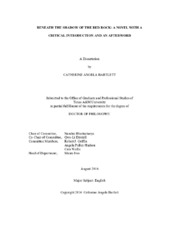| dc.description.abstract | This scholarly-creative dissertation uses a decolonizing storytelling methodology
to investigate the 1979 Church Rock uranium spill near Gallup, New Mexico, where an
open-air uranium waste pond breached its earth dam, releasing over 1,000 tons of
radioactive mill waste and 93 tons of tailings into the Río Puerco. Contaminants traveled
over eighty miles downstream, poisoning ground water, livestock, and sacred land
primarily on Navajo-Diné lands. In the decades since, a full waste cleanup has never
been conducted, families have remained on their poisoned homelands, and the spill’s
health effects have claimed many lives. A scholarly introduction disrupts a singular
American ecocritical genealogy by disentangling the linkages between settler colonialism, gender, spatiality, and race among those affected by uranium mining along
the northwestern corridor of New Mexico. This introduction also presents postcolonial
ecology and alternative cartography as well as characteristics of Indigenous and Chicana literary production, and affect theory in its abilities to re-member the spectral, racialized female subject.
The creative portion of the dissertation is a novel, which deploys a decolonizing
storytelling methodology to focus on the wellbeing of an Indigenous-Chicano family and
its community, in particular its Chicana-Indigenous narrator, through an enactment of
slow violence that leads up to the uranium spill, documents the dissolution of the family,
and points to the spill’s (after)effects. The novel elevates community and kinship, communal ties to the land, and tradition-based knowledge as central tenets of
environmental justice movements. The novel also challenges concepts of Latin
familism such as collectivism and interdependence that typically constitute an ethics of
care and caring. An afterword presents my own process as a novelist.
Finally, a creative nonfiction essay presents my own process as a novelist and
offers some pedagogical implications for classroom discussions about the novel. It also
discusses shared similarities with the more traditionally defined area of literary
cartography, specifically the prevailing notion of the story as a cartography of discovery.
Rather, I argue that alternative cartographies are less about discovery and more about
excavating the stories already sedimented within disenfranchised communities, the land
itself, and the re-member bodies of formerly spectral, racialized female characters. | en |


